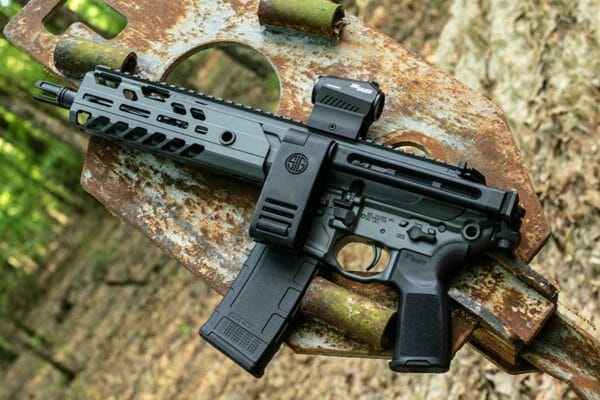
Late Wednesday, a Texas-based Federal District Court judge issued a nationwide stay preventing the Bureau of Alcohol, Tobacco, Firearms and Explosives (ATF) from enforcing its rule on pistols equipped with stabilizing devices (2021R-08F).
The case, Britto v. ATF, challenged the “Factoring Criteria for Firearms with Attached ‘Stabilizing Braces'” rule. The ATF created the regulation after an executive order by President Joe Biden directing the Bureau to deal with pistol braces. The ATF would reverse years of classification letters and revoke previous determinations issued to brace manufacturers.
The Britto case challenged the rule, claiming the ATF pistol brace rule violated the Administrative Procedures Act (APA). The plaintiffs felt the final rule wasn’t a logical outgrowth of the proposed rule. The proposed rule had a point system (ATF Form 4999) that helped individuals determine if their firearm would be considered a braced pistol or short-barreled rifle (SBR). Most of the comments during the public comment period addressed concerns with the form.
When the final rule was unveiled, the point system was removed. The ATF considered all braced pistols on the market to be SBRs and subject to the National Firearms Act of 1934 (NFA). Gun owners had four choices.
The first choice was registering their firearm with the ATF per NFA regulations. Gun owners would have to provide pictures of the firearm’s markings, give the government fingerprints, and submit passport pictures to the ATF. Some states, such as California, do not permit NFA items.
The second choice is for gun owners to replace the barrel with a barrel over 16 inches. This change would make the firearm a rifle regulated under the Gun Control Act of 1968 (GCA). It would mean that the gun owner would have to spend money on expensive rifle parts to bring their firearm into compliance. The third choice is that the gun owner could opt to remove the brace and render it non-reusable, effectively destroying the brace.
The final choice for the gun owner is to turn the firearm into the ATF. Many in the gun world saw this as a forced confiscation by a hostile anti-gun government agency. Firearms are not cheap, meaning that gun owners might be out several hundred to several thousand dollars. If the gun owner chose not to make any of these choices and the ATF caught them, they could be charged with a felony punishable by ten years in prison. This punishment is the same as owning an unregistered machinegun.
Several factors must be met for a plaintiff to obtain an injunction. The first is the likelihood to succeed on the merits of the case. District Court Judge Matthew Kacsmaryk of the Northern District of Texas, Amarillo Division, ruled the plaintiffs had a high likelihood of success. The Judge leaned heavily on the Mock v. Garland ruling.
In that case, the Firearms Policy Coalition (FPC) claimed that the ATF overstepped the boundaries set by the APA. The Fifth Circuit Court of Appeals agreed with the plaintiffs in the case. Judge Kacsmaryk referenced that decision in determining the likelihood of success by the plaintiffs in Britto. He came to the same conclusion as the Fifth Circuit.
“Given the Fifth Circuit’s holding, this Court recognizes that the Rule ‘was not a logical outgrowth of the Proposed Rule’ and ‘must be set aside as unlawful.’ That holding alone establishes that Plaintiffs’ have demonstrated, a fortiori, an actual success on the merits of their APA challenge to the … Rule,'” The decision read.
The second factor is whether the plaintiffs would suffer irreparable harm without an injunction. Gabriel A. Tauscher, one of the plaintiffs and a Marine, has a partially paralyzed arm due to a combat injury. The creation of the original stabilizing brace aimed to assist a veteran who suffered an injury in combat. Much like that vet, Mr. Tauscher couldn’t shoot his AR-15 pistol without the help of a stabilizing brace. Other gun owners would also suffer harm because the rule doesn’t have a grandfather clause. The judge quoted the judge in the Gun Owners of America (GOA) case challenging the rule.
“‘Under the Final Rule, compliance will almost always come at a cost. When the Fifth Circuit sent Mock back to the district court, the court evaluated the irreparable harm, if any, that several private plaintiffs in the case would suffer. Because the Mock plaintiffs owned firearms and stabilizing braces that the Final Rule would classify as an SBR, the plaintiffs had ‘no trouble establishing a substantial threat of irreparable harm in the form of nonrecoverable compliance costs.’ The same is true here,” the judge wrote.
The final step to get an injunction is to prove that an injunction is in the public interest. The judge found that since the rule is not a logical outgrowth of the APA, it is most likely illegal. The government cannot use public interest to defend an unlawful rule. Therefore, the public interest falls on the side of the plaintiffs.
Because of these reasons, Judge Kacsmaryk stayed the rule in its entirety. The ATF is likely to appeal the decision. FPC, GOA, and SAF members were the only ones to whom the previous injunctions applied. Now, protection extends to everyone in the nation.
Britto v ATF Motion for Prelim Injunction by AmmoLand Shooting Sports News on Scribd
About John Crump

from https://ift.tt/ohZ0kPy
via IFTTT

No comments:
Post a Comment